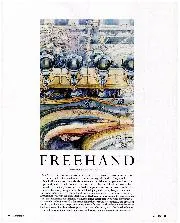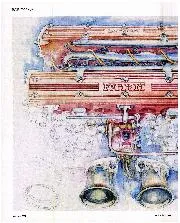

Freehand
Bob Freeman is never entirely happy with any of his drawings; he says he never knows exactly what direction they will go in, or how they will finish – if…
been prepared for the gruelling tests of road and track by the methods I will now explain in detail.
Testing a Likely Chassis.
According to manufacturing theories, every chassis of a similar series is just as good as any other in its batch, but when one gets down to the finer points, it is often found that there are noticeable variations. If I were asked to describe these variations, I must confess it would be difficult, but there is something about the ” feel ” of certain cars, which makes one quite confident in embarking upon the lengthy job of tuning up, with absolute confidence of ultimate success. On the other hand, there are cars which one turns down, with no
apparent reason other than the intuition which comes from long experience of handling high efficiency machines of all types.
With regard to the important question of reliability in racing, the governing factors cannot be gauged by any kind of preliminary testing, though the latter is necessary to find out whether the car selected possesses the other essential qualifications. The kind of reliability to which I refer is the product of painstaking efforts on the part of the racing owner, and it is a matter of months’ instead of weeks’ work to carry out the system I have used successfully in connection with road and track racing.
Looking for Hidden Defects.
If one’s racing ambitions are likely to be satisfied by winning a few short events, then mere speed is more important than speed plus reliability ; but the combination of the two factors is essential for consistent long
distance performance. The first step in search of reliability is to strip the entire chassis down to its two side members, dismantling every single unit for the closest examination. Any parts which show the least trace of wear must be ruthlessly scrapped, so that when the reassembling is completed, the car is in perfect mechanical condition. This done, it should be taken on the road and submitted to speed and hill climbing tests, in which acceleration and braking are carefully noted for future comparisons. Assuming that the work done up to this point is satisfactory, we return to the workshop and the units are again dismantled for the second stage of the proceedings. This consists in tuning up the engine to get
the best possible results, prior to making any alterations or deviations from standard practice, in the way of modified timing, though certain parts may be lightened to give extra speed.
The second road test will show what improvements have been effected, and if the results are satisfactory the engine should be taken down again in order to carry out further modifications. There is no need for me to go into details of modified camshaft settings, for this subject has been dealt with already in BROOKLANDS GAZETTE, but I would point out the necessity for trying the car on the road after each alteration has been made. For example, if one has fitted a new camshaft and altered the compression ratio of the engine, it is impossible to say which of the two items has made an improvement unless separate trials are made of each, and the same thing applies to each of the many modifications that are possible in
tuning up an engine to give ultra efficiency—one thing at a time should be the tuner’s motto.
It is a case of carrying out the improvements bit by bit, until one is satisfied with the ultimate results, as otherwise it is possible to overdo one individual operation to the detriment of another and thus lose some of the efficiency that might otherwise be gained.
Fining Down the. Chassis.
When everything that can be done to improve the engine has been completed, work on the chassis may be commenced ; and here again, the tests must be made after each minor process.
A really efficient chassis means additional horse power, and too much attention cannot be paid to obtaining all the possible horse power from the engine at the road wheels. The reduction in chassis weight is helpful, but care is necessary for many a race has been lost, and the lives of drivers endangered, by an excess of zeal in this direction. Then again the steering must be set and adjusted to give the last degree of accuracy and sensitiveness, whilst equal attention will be necessary for the brakes. Many racing drivers err on the side of getting a disproportionate acceleration—braking factor, with the result that valuable seconds are lost on corner work.
The final tests, to be of any real service, should extend from two to three hundred miles, and, if a road race is in view, the tests must be made on the road, as the conditions of track work are less arduous than those of the road, especially from the chassis point of view.
Short sprints at racing speed are of little value in preparing a car for any big event, and I find that one can do the necessary amount of road testing by getting up quite early on a Sunday morning, without making oneself a nuisance to other road users, whilst the guardians of the law are busy dreaming about the” controls” they will operate when the week-end motorists begin to throng the main thoroughfares.
As a rule, I have made a point of putting in at least a couple of months at serious practice work, going out on every Sunday morning during this period, prior to a big road race ; so that it will be seen that nothing is left to chance in order to avoid that bête-noir of all racing drivers—last minute alterations.
I can assure my readers that the Continental cracks are most assiduous in preparing for big events, and those who aspire to international honours cannot do better than to follow their example. The value of racing reliability has been brought home to me very forcibly during the last few years, and perhaps I may be permitted to remark that this aspect of racing has occupied my attention far more than mere speed work. Perhaps the methods I have suggested may appear a little elaborate to readers who hitherto have looked upon speed as little more than a burst of a few minutes duration on the track ; but in support of my system I may say that the long distance performances of my Bugatti’s in the T.T., the Boulogne and the Two Hundred Miles races, lead me to think that painstaking efforts bring their own reward.